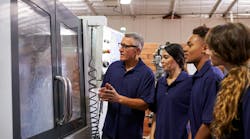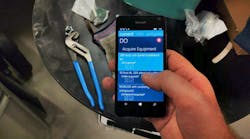Like your grandpa's tingling trick knee calling out rain, equipment manufacturers are sensing something dark on the horizon. Soon there may not be enough people to use their tools and machines, and a tsunami of supply and demand will wash away many companies' solvency and very existence.
It's the perfect storm created by an aging workforce edging ever closer to retirement and colliding with an entry-level generation whose relationship with work can be described as "It's complicated."
One side, the Baby Boomers, won't be able to work physically demanding jobs, with the last of them hitting 65 by 2029. The equally sized millennial population doesn't seem willing to take their place on the factory floor. Throw in increasingly capable automation systems and the rise of developing nations and you have a forecast that's super cloudy with a chance of sh**balls.
It even has manufacturers that predate the Civil War questioning the future.
"Quite frankly, we're worried that there won't be enough people to get the job done," says Greg Palese, vice president of marketing at Klein Tools, which was founded in Chicago in 1857. "And I think that's sort of echoed throughout the industry, whether it's electricians, plumbing, construction, whatever it might be. There is a big skills gap there."
Right now, nearly half of all small businesses, ranging from construction to automotive to heavy equipment reporting can't find qualified applicants, according to the National Federation of Independent Business.
"When these types of jobs go unfilled, U.S. businesses expand more slowly and the nation's growth is impeded," concludes Robert S. Kaplan, President and CEO of the Dallas Federal Reserve.
Think of manufacturing as "The Giving Tree" and the current workforce as the boy.
As our society has aged, we've really just been taking—sawing off branches to pay corporate taxes and watching leaves wither and seeds blow away to foreign lands, all the while expecting it to sustain us.
Deloitte predicts that by 2025, 2 million of the 3.4 million manufacturing jobs needed in America will go unfulfilled. Considering one-third of America's GDP comes from manufacturing, it will be a challenge to keep up the record production output even if more positions are filled by robots. By then the machines are only predicted to fill 7% of jobs, according to Forrester.
If things don't change soon, our economy will end up like the boy in "The Giving Tree," grown old and weak, left with merely a stump that can bear no more fruit.
Root of the Problem
Currently, there are 6 million open jobs overall with 6.8 million looking, according to April BLS data.
Based on the math, companies should be in great shape, but this 6.8 million-person pool isn't teeming with the skilled talent they are trying to hook.
"Today a lot of people we talk to are turning down work because they just simply don't have the people to get the job done," Palese says. It's akin to Alanis Morissette's song "Ironic": "It's like 10,000 spoons when all you need is a knife." We have 10,000 baristas when all you need is an electrician.
And that means, if you are an electrician, your prospects are great right now.
"From a supply and demand standpoint, I think that means that those who are entering the trades now will be busier than ever, and hopefully that means more prosperous as well," Palese says.
So how does a country that less than 10 years ago had a 10% unemployment rate get to a point where we have too many jobs?
We got here because we tell our kids they can be anyone they want to be—and a lot of what they want to be, we don't necessarily need. Then expect someone else's kid to do the dirty work.
After all, our parents worked in factories and mills and plants, coming home stinking of chemicals and ash, collapsing on the floor for a brief respite. They wanted more for their progeny and pushed us towards "white collar" jobs that paid well or to fields where we could truly be ourselves, or pursue the happiness that they missed out on.
How else can we explain the harrowing results of the "2015 Manufacturing Perception Study"? In it, millennials (ages 19 to 33) ranked manufacturing as their least preferred career destination. In another study done by the Foundation of Fabricators & Manufacturers Association, more than half of the polled teenagers had no interest in manufacturing.
They stereotyped a manufacturing job as a "dirty, dangerous place that requires little thinking or skill from its workers and offers minimal opportunity for personal growth or career advancement."
As someone who covers every facet of manufacturing, I can see this as patently false, and I would seriously question the methodology and efficacy of these surveys if not for having encountered so many teens and twentysomethings who know little to nothing about how advanced industry has become
If you grew up loving science-fiction space operas, all that technology is yours to play with and improve upon now. Robots, 3D printing, artificial intelligence. Using these existing technologies and some basic Google and YouTube searches, a crafty, dedicated novice can build their own Star Wars BB-8 astromech.
If curing cancer is your life’s pursuit, or more likely, making six figures, you can become an oncologist after four years of undergraduate work, four years of medical school, and possibly another eight years of internships and residency before helping a single cancer patient. In two years, you could get the associate’s degree required to become an MRI repair technician, or spend a few years more in college and someday develop a cheaper, more efficient MRI machine.
All of these people are necessary for the fight against cancer, but only one accrued student loan debt in excess of $166,000, which when paid off three decades later ends up being around $420,000 if interest is 7.5%. You also wouldn’t be earning a salary for about eight years.
This is an extreme case, but an example of how more college doesn’t directly mean more money.
Former "Dirty Jobs" host Mike Rowe is possibly the most vocal and certainly the most articulate advocate for changing the way we think of education to address the skills gap.
"If you have the desire and money to pay for a four-year degree, I say go for it," Rowe says in a recent Facebook video. "But look, we need to stop promoting a four-year education at the expense of every other form of learning. It's just crazy."
His non-profit, the MikeRoweWORKS Foundation, offers several scholarships to encourage "shovel-ready" jobs. Its Profoundly Disconnected campaign was built to fix America's perception of manufacturing and other industrial jobs, including carpenters, electricians, pipefitters, steamfitters, plumbers, and more.
"Fifty years ago these jobs were critical," Rowe says. "They still are. The problem is we don't value them the way we used to, so we don't encourage people to pursue them. We're so concerned with how to get into the corner office, we forgot how to build a corner office."
Seeing Red
You could argue we, as a country, also forgot about the people who build those corner offices and everything else in this country. It may also be the reason that Wisconsin, a traditionally blue state that relies on manufacturing, bucked its democratic leanings and voted for Donald Trump in the 2016 presidential election. He was the first Republican to carry the state (which he did by 23,000 votes) since Ronald Reagan.
In several trips, Trump promised to fortify the Dairy State's manufacturing backbone with more jobs and better trade policies, while Democratic nominee Hillary Clinton did not make any visits, though she did detail how her dad made drapes during a debate.
Manufacturing jobs constitute about 15% of Wisconsin's total employment, based on May 2017 BLS data. Wisconsin lost a quarter of its 600,000 manufacturing jobs from 2000 to 2010.
Trump, the former host of "The Apprentice," recently returned to Wisconsin, where he now has a 41% approval rating, to the Waukesha County Technical College near Milwaukee. Joined by Gov. Scott Walker, he arrived to advocate the use of apprenticeships and for students in high schools across America to be able to "learn while you earn."
Last year, the previous administration received congressional approval to dole out $90 million to advance the apprenticeship program. Trump signed an executive order on June 15 to double the funds for apprenticeships to $200 million to boost the current amount of 500,000 apprentices.
You don't need a math lesson to know that merely doubling our efforts is like trying to fill the crater-sized skills gap with two garden shovels instead of one.
Salesforce CEO Marc Benioff challenged POTUS to get to 5 million apprenticeships in the next five years.
This is something all of Trump's inordinate ambition and loads of taxpayer money can't accomplish alone. Hillary Clinton famously wrote it takes a village to raise a child. To teach that child marketable skills, it will take a plant.
Sourcing the Apprentice
In Northeastern Wisconsin, nearly one in four jobs is related to manufacturing, compared to less than one in 10 nationally. This is a place that can't afford for open jobs to go unfilled, and luckily the region didn't wait for politicians to take notice.
Eleven years ago, the Northeast Wisconsin (NEW) Manufacturing Alliance was formed to ensure this doesn't happen.
Essentially, the partnership between schools and 200+manufacturers across 18 counties makes manufacturing cool again, by actively promoting manufacturing careers and the STEM skills required to do them in ways students won't find depressingly boring, such as practical math videos that answer the age-old math question: "When am I ever going to use this in the real world?"
Instead of a worksheet full of fraction problems, a classroom would view a Get Real Math! video that introduces a situation one might see on the job. For example, in one a welder must measure the discontinuities in a bend specimen and add the fractions to check if a weld meets structural steel code criteria. The video has breaks where the teacher would go into more detail about how to add 3/64 and 3/32.
Then additional videos can be shown spotlighting the careers featured in the video.
There are currently 23 videos on the site, and Ann Franz, director of the NEW Alliance, says the goal is for junior high students to pick up interest in math skills in junior high, focus on technology classes in high school, and then go to a two-year technical school or earn a four-year degree related to manufacturing.
It's manufacturers doing what they do best: engineering and implementing a more productive solution to stay in business. In this case, they are molding their future workforce, because the education system has failed to do so.
"School counselors usually have between 200 and 300 students," Franz says. "How much time is really spent giving those students one on one about their careers in any profession, let alone manufacturing?"
She learned you can't simply tell a student that a trade can be a fulfilling pursuit, but you must adopt a "show-don't-tell" policy.
"I used to go out and tell kids to go out and be a welder," she says. "But if it's so great then why aren't I a welder?"
That's why additional videos were created to spotlight the careers featured in the video.
For a real taste of what plant life is all about, the organization arranges for hundreds of students to tour manufacturing facilities each year.
Andy Bushmaker, a production manager at KI, a furniture maker, who also appeared in the first Get Real Math! video and works closely with NEW, shows the students around the robots, tool and die, and assembly areas and points out how math is used in each, such as figuring out the ratio of colorant to raw material in plastic injection molding. For tube bending, geometry is the focus.
KI also takes part in adult apprenticeships at their tool and die shop and a few youth apprenticeships, as well. The state's non-profit GPS Education Partners has an education center at KI where students spend two hours a day before going out on the factory floor, or to other manufacturers, to work a six-hour shift. The downside is there is the juniors and seniors enrolled in the program don't get a summer break, but they do get paid and end up with a diploma.
"Many of the students who go through this program are hands-on learners, and some of them were struggling in high school," Bushmaker says. "This is a way to get them back on track and graduate on time."
Not only that, but Bushmaker says the on-the-job training provides the problem-solving and communication skills employers are looking for.
Franz believes the engagement has created a big difference. She says in 2005 there were 193 students enrolled in welding programs at the four local technical colleges, while last year there were 835, for a 432% increase. For machinists, enrollment jumped 284% over the same period.
Franz notes that although half of the parents nationwide still don't view manufacturing as exciting, challenging, or engaging, according to a 2017 SME study, a regional survey done by NEW found that "72% of parents said manufacturing is an exciting and rewarding career."
Franz has traveled the nation teaching other organizations how to achieve the same results, and little by little, fill the gap.
She's learned one thing that is probably obvious to anyone who's made a living out of problem-solving and building solutions:
"The number one thing is manufacturers have to lead it."




















